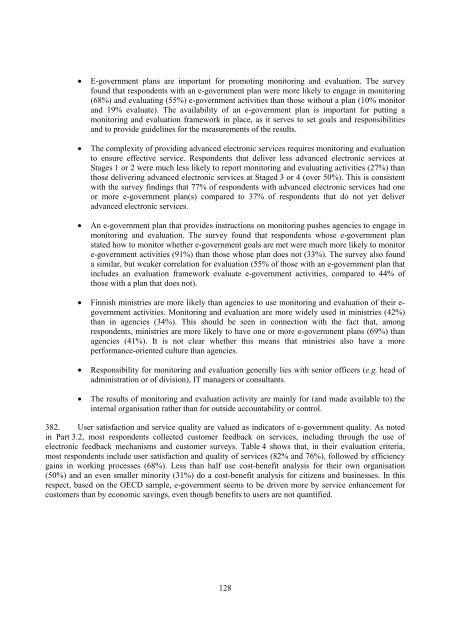e-GOVERNMENT IN FINLAND - ePractice.eu
e-GOVERNMENT IN FINLAND - ePractice.eu
e-GOVERNMENT IN FINLAND - ePractice.eu
You also want an ePaper? Increase the reach of your titles
YUMPU automatically turns print PDFs into web optimized ePapers that Google loves.
x E-government plans are important for promoting monitoring and evaluation. The survey<br />
found that respondents with an e-government plan were more likely to engage in monitoring<br />
(68%) and evaluating (55%) e-government activities than those without a plan (10% monitor<br />
and 19% evaluate). The availability of an e-government plan is important for putting a<br />
monitoring and evaluation framework in place, as it serves to set goals and responsibilities<br />
and to provide guidelines for the measurements of the results.<br />
x The complexity of providing advanced electronic services requires monitoring and evaluation<br />
to ensure effective service. Respondents that deliver less advanced electronic services at<br />
Stages 1 or 2 were much less likely to report monitoring and evaluating activities (27%) than<br />
those delivering advanced electronic services at Staged 3 or 4 (over 50%). This is consistent<br />
with the survey findings that 77% of respondents with advanced electronic services had one<br />
or more e-government plan(s) compared to 37% of respondents that do not yet deliver<br />
advanced electronic services.<br />
x An e-government plan that provides instructions on monitoring pushes agencies to engage in<br />
monitoring and evaluation. The survey found that respondents whose e-government plan<br />
stated how to monitor whether e-government goals are met were much more likely to monitor<br />
e-government activities (91%) than those whose plan does not (33%). The survey also found<br />
a similar, but weaker correlation for evaluation (55% of those with an e-government plan that<br />
includes an evaluation framework evaluate e-government activities, compared to 44% of<br />
those with a plan that does not).<br />
x Finnish ministries are more likely than agencies to use monitoring and evaluation of their egovernment<br />
activities. Monitoring and evaluation are more widely used in ministries (42%)<br />
than in agencies (34%). This should be seen in connection with the fact that, among<br />
respondents, ministries are more likely to have one or more e-government plans (69%) than<br />
agencies (41%). It is not clear whether this means that ministries also have a more<br />
performance-oriented culture than agencies.<br />
x Responsibility for monitoring and evaluation generally lies with senior officers (e.g. head of<br />
administration or of division), IT managers or consultants.<br />
x The results of monitoring and evaluation activity are mainly for (and made available to) the<br />
internal organisation rather than for outside accountability or control.<br />
382. User satisfaction and service quality are valued as indicators of e-government quality. As noted<br />
in Part 3.2, most respondents collected customer feedback on services, including through the use of<br />
electronic feedback mechanisms and customer surveys. Table 4 shows that, in their evaluation criteria,<br />
most respondents include user satisfaction and quality of services (82% and 76%), followed by efficiency<br />
gains in working processes (68%). Less than half use cost-benefit analysis for their own organisation<br />
(50%) and an even smaller minority (31%) do a cost-benefit analysis for citizens and businesses. In this<br />
respect, based on the OECD sample, e-government seems to be driven more by service enhancement for<br />
customers than by economic savings, even though benefits to users are not quantified.<br />
128
















